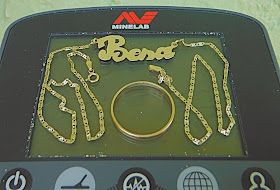Many beach hunters struggle to find gold chains at first, but once you find gold chains the audio response become easier to recognize.
A gold chain in your scoop basket can come from the most unimpressive and unlikely target response.
Similar to how a faint signal can turn out to be a deeply buried big gold ring, big gold chains only a few inches deep without pendants can be short faint signals.
It is highly unlikely that the average beach hunter walking along the beach will detect even a good size gold chain without a pendant.
When using my Minelab metal detectors, a low tone from a gold chain can be fleeting, even when plodding along using a slow sweep speed.
That is why it is so important to investigate any low tone signal, no matter how abrupt or faint it may sound.
There is a good chance you can hear the same signal again, if you move your search coil away and bring it slowly back over the original target area using a short sweeping wiggle motion.
If you detected a gold chain without a pendant, you may only have picked up the lobster clasp.
If the gold chain has a pendant, it may only be the pendant you detected.
Slow methodical beach and shallow water hunters will have a better chance of finding gold chains than people who try to cover an area quickly.
Many of my largest gold chains, with and without pendants, came from soft unimpressive signals.
Loud booming low tones can have you thinking gold chains, but turn out to be tin cans and sunglasses.
It is the signals you think are not going to amount to much, that turn out to be gold chains and bracelets.
A useful tip when investigating fleeting low tone signals on the beach, is to use your foot to move sand across the target area.
I recovered this gold necklace last year after investigating a short faint low tone in the dry sand and moving the sand with my foot, I saw the necklace and picked it up and put it in my finds pouch.
The 18K gold ring in the photo was found a few feet away from the gold bracelet, perhaps someone had taken this gold jewelry off before going swimming and lost them.
Most of my gold chains and bracelets have come from the towel line in the dry sand and along the high tide line on tourist beaches.
Mole-ing around beach entrances using a tight search pattern and small search coil, is an excellent way of increasing your chances of finding gold chains and bracelets.

No comments:
Post a Comment